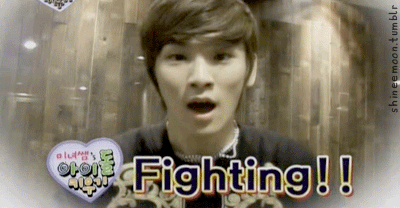Learning Japanese #1 - Basic Pronounciation & Grammar.
Basic Pronunciation & Grammar.
Let's begin!
--------------------------------------------
ARE WE READY TO LEARN SOME BASIC JAPANESE?!

YEY, Kpop inspiration... I should really find some jpop pics... /cough.
-----
LOOK AT MY LESSON PLAN HERE:
-----
ANYHOW, let's begin~
Before we Start:
Please take a look at this article. It will help you learning to type in Japanese words, and this will help you learn them better. For those of you that can't open the link (for some reason...), just C+P this: http://office.microsoft.com/en-gb/word-help/switch-between-hiragana-and-katakana-in-japanese-text-HP005251038.aspx
Yup Yup, we're ready to go~
Romaji
First off, let me tell you what ROMAJI is, for those of you that don't know. This is basically taking a Japanese word, and writing the Romanization of it. It helps us pronounce the words, which otherwise we'd have trouble doing so.
EXAMPLE TIME:
tea in Japanese is: お茶 . Imagine being given that, and being told, right, learn that word, it's the word for tea. Umm... Very difficult! So, we have romaji, which turns お茶 into ocha. Ocha is basically 'お茶', but just how we pronounce it, in English.
That's a very basic explanation (^_^; ) if you'd like further reading into WTF romaji is, Google it. Otherwise, just take my word (haha). It's just, simply put, the 'roman' (English...) way of pronouncing the Japanese language.
I'm gonna be using this quite a bit, since it's the best way to first learn to SPEAK Japanese. When you begin using romaji, it also helps when learning to write in Japanese (Especially using a keyboard - see above!), as all you have to type in is the romaji syllables.
EXAMPLE: Konbanwa. In Japanese, this means 'Good Evening'. If we want to input this into Japanese using a keyboard, we'd just type in 'KON BAN WA" and VOILA, it will come up in Japanese. Clever technology!!
Simples, right? ....

Moooving swiftly on...
Sounding Vowels:
So, there are 5 vowels. The words in brackets are to show an example of the sound. I've also given the hiragana for the word for all those eager to start Hiragana learning~
あ A - (America)
え E - (Yes)
い I - (Irate)
お O - (Not)
う U - (Peru)
Each vowel should be said separately, but smoothly. For example, Tokyo would be: Toh-Kyo.
Try practice saying these random Japanese words, practicing the vowel sounds: Kara, Demo, Ima, Chotto, Tsuma.
Sounding Consonants:
Consonants are pronounced just like in English, though there are a few tricky ones, such as:
Ch (Child) - NOT like in Charisma
F - Should be said softly. Practice saying this without letting your teeth touch your lips.
G (Go) - NOT like Gillian.
J (Jam)
TT (teh) -- Note: When you come across doubles like this one, you pause a little before you say them. For example, the word matte, would be ma-tte.
Ya, Yo, Yu -- Each word makes just ONE sound. An example would be the word Kyoto. When pronouncing the word, it should be pronounced Ky-Yo-To.
We tend to give syllables different amounts of stress when pronouncing them, but in Japanese, EVERY syllable should be given the same amount, almost making them sound 'flat'.
I'll give an example: Pronounce the word "Hiroshima" out loud.
I'm betting quite a lot of you put a bit more stress on the "Oh" syllable, making it sound like HiROshima, when ALL the syllables should be given equal stress.
Practice saying the word out loud. I know it seems weird, because it's almost like talking in monotone, or like you're unimpressed, but that's honestly how ALL the words should be pronounced, with ALL the syllables given the same amount of stress.
---
So... That was just the VERY basics of pronunciation. Are you all still with me?

Heh heh, of course you are! We can do this! ^_^;
Word Order
The best way to describe the Japanese wording order is 'back to front'. For example, this basic phrase:
Are you a student? ( あなたはがくせいですか?) Once given a LITERAL translation, becomes: You student are? Kinda complicated when you begin to learn the individual words in more detail, but after a while you begin to pick up on it.
Basically, the preposition (to, at, in, from etc) goes AFTER the place, and the verb goes at the end. So, example:
I am going to Tokyo --- Tokyo (place) to (preposition) i am going (verb).
Basically, talking backwards!

(How i felt doing it at first ;___; )
Article
The Japanese don't use an article. Therefore, it's not THE bank, but just simple, Bank. So basically, this phrase: I worked at the bank in Japanese would be like us saying I worked at bank (Ginko de hataraiteimash(i)ta). Doesn't make sense to US, but in Japanese, it makes perfect sense.
Questions (?)
In Japanese, they don't even have to use question marks to show they are asking a question. Instead of a question mark (?), they use 'Ka'. So the phrase, Are you from London? Would literally look like: London from are you (London kara desu ka). No need for a question mark, because as soon as you see KA at the end, you KNOW it's a question.
Wa
If you see the word 'WA' in a romanized text, look to the LEFT of that word - it will tell you what the conversation is about. Cool eh?
Example: Honda wa do desu ka. Looking left, we can see that the topic is about HONDA. It may seem a little 'over the top' and not really necessary, but wait until somebody gives you a WHOLE conversation in Romaji and you're like "DAFUQ?" - Don't worry, scan for 'WA' and know what the topic is about. SIMPLES.
----

THERE WE HAVE IT!
You're first lesson on BASIC pronunciation and Grammar! I'd recommend reading over it a few times, until you know the most important parts like the back of your hand (sounding, word order, questions) are the most important, i'd say, but really, if you'd like the next few lessons to run easier, learn them all~
Homework
(Should you choose too...)
Some words to learn:
- Sumimasen - Excuse me, sorry
- Ban - number
- Chotto - a little
- Matte - wait
- Kudasai - Please (May i have?)
- Hajimemae - How do you do?
- Iie - No
- Hai - yes
- Watashi - I
- Doko - Where
- Mo - also
-----------------------
If after reading this (and reading again) you are like the girl in this picture, just leave a comment and I’d be happy to answer any questions regarding THIS lesson. (please don't post questions asking me to translate or how to say 'so and so', JUST WAIT FOR THE OTHER LESSONS ^__^;;
NEXT LESSON -
We shall be looking at Japanese Hirigana & the Japanese alphabet. EXCITED? I bet you are ^_^;;
---
If you found this lesson useful, please make sure to COMMENT back on the JAPANESE LESSONS STORY so that others can notice it, too.
Just click back HERE
Comments